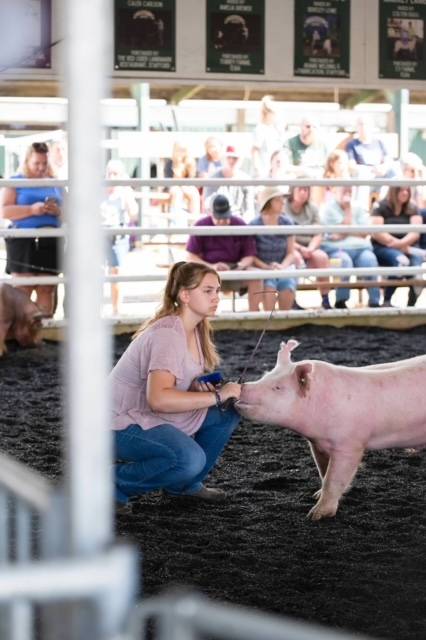Christmas Lights around Genesee County

This is part one of a two part series featuring Christmas lights around Genesee County.
Photos by Steve Ognibene







This is part one of a two part series featuring Christmas lights around Genesee County.
Photos by Steve Ognibene







After eight years on dialysis and currently living with a deteriorating transplanted kidney, Batavia resident Jim Urtel Jr. is reaching out to a charitable organization that has taken a page from the “it takes a village” model.
Urtel, 54, a Le Roy High School graduate and longtime trainer/groom of racehorses, needs a second kidney transplant – this time from a live donor.
In an effort to speed up the process, he has connected with Kidneys for Communities, a nonprofit that is dedicated to increasing the pool of living kidney donors in the United States.
“I found out about Kidneys for Communities last June from an old friend, her name was Pam, that I met back in 2020, when I got the first transplant,” Urtel said on Friday. “I just started looking online to see if I could find any help or something. Thankfully, this (organization) helps people like me who need a kidney from a live donor.”
Urtel, encouraged by his parents and by his partner of 30 years, Renee Hozlock, is doing the things he needs to do – exercising regularly (he’s dropped 50 pounds), counting his calories, drinking plenty of bottled water and maintaining a positive attitude – as he waits for a donor.
Prior to 2012, Urtel was busy in the harness horse racing industry, mostly in Pennsylvania. An only child, he came back to Batavia to be there for his mom after his grandmother became ill.
“I was getting ready to work for a guy at the track here in Batavia and I had been a little bit sick for about a week or so. When I laid down at night, I had trouble breathing,” he recalled. “So, I decided to go to the emergency room and get checked out. I thought I had pneumonia or maybe bad bronchitis.”
After testing, he was told that his blood pressure “was through the ceiling,” he said, and that his kidneys had shut down.
“I had untreated sleep apnea and that was raising the blood pressure,” he said.
It was then that he started on dialysis and that lasted for eight years before he received a transplant in 2020 from a deceased donor. As it turned out, there were problems with the transplanted kidney.
“The first year was rough. I had tons of extra fluid. They couldn’t regulate the blood pressure and I gained 50 pounds,” Urtel said. “Little did I know, this kidney was bad, they didn’t tell me that. I think it was a little bit of a little story to keep me going.”
Tested recently, it was determined that his kidney failure risk factor was at a high level, once again making him eligible for a transplant.
“This time, it's going to have to be a live donor because I already did eight years of dialysis and the average lifespan on dialysis is seven,” he said. “That’s why I’m working with Kidneys for Communities. They have pairing programs and other ways to find matches.”
While Renee said she was willing to donate one of her kidneys, she’s not a match.
The chief executive officer for Kidney for Communities said he can relate to Urtel’s plight.
“First of all, I'm a kidney recipient myself,” Atul Agnihotri said by telephone on Friday. “So, I sort of know what Jim's going through and that’s the foundation of how we started this organization. I felt that I got lucky when I received my kidney, and a lot of people in the same journey with me were not as lucky.”
Agnihotri said his organization focuses on sharing patients’ stories in their own communities to maximize their chances of receiving transplants.
“We know that within the community is where the affinity, the relationships and identification is the strongest,” he said. “And members are willing to help other members. A community could be that you are living in a smaller city were people have this binding relationship with each other, or you could be going to the same church.”
Kidneys for Communities does not charge a fee to donors, recipients or transplant centers, Agnihotri said.
“We collect our own funds. All our funders currently are people that are associated with kidney disease, either their themselves as recipients, family members of the recipients or their donors,” he explained.
“If you look at our organization, we have an incredible list of people that are associated with it. A lot of those people are altruistic donors, meaning that they just kind of like walked in and said, whoever needs a kidney, I'm willing to give one.”
And that’s just the type of person that Jim Urtel is hoping to find.
For more about how to help Urtel: https://kidneysforcommunities.org/recipient/jim-urtel/
For more information about Kidneys for Communities, go to www.kidneysforcommunities.org.
Brian Cline recorded the third-highest series in Genesee Region USBC history on Monday night, posting 857 in the Mancuso Real Estate League at Mancuso Bowling Center in Batavia.
The 45-year-old left-hander, who has around four dozen 800 series to his credit, rolled games of 299-300-258 on lanes 7-8.
The Middleport resident left a 3-pin on the last ball for 299 in the opening game, which saw his teammate Paul Bacon register a 269 game.
He followed that with the perfect game, and then added eight more strikes in the last game. He had a shot for 280 in the third game but left a 7-pin on the first ball in the 10th frame.
The 857 trails only an 858 rolled by Cline in January of 2018 at Mancuso's, and fellow lefty Rich Wagner's 899 in February 2011 at Mancuso's.
Cline's best three-game series is an 868 at Transit Lanes in Buffalo in November 2013.
In other league play:
-- Robbie Hanks and Jeff Shawver each rolled 300 games in the Sneezy's Monday Night League at Oak Orchard Bowl in Albion. Hanks finished with 721 and Shawver shot 686. It was the first United States Bowling Congress-certified for Shawver.
-- Justin Thering rolled a 300 game in a 640 series in the Wednesday Community League at Medina Lanes. The 29-year-old right-hander upped his average to 218 with his second USBC-certified perfect game. His first came in Lockport in 2021 en route to an 816 series.
The Christmas Eve Service at City Church starts at 10 a.m.
Press Release:
Genesee County Sheriff’s Office, the City of Batavia Police Department, and the Village of LeRoy Police Department will be participating in a coordinated effort with the Genesee County STOP-DWI program to bring awareness to the dangers of impaired driving.
Law enforcement officers and STOP-DWI programs across New York State will be participating in a combined effort to bring awareness to the dangers of impaired driving, prevent injuries, and save lives.
The campaign, which runs through January 1, aims to educate people about the dangers and consequences of driving drunk. Highly visible, highly publicized efforts like the STOP-DWI High Visibility Engagement Campaign aim to further reduce the incidence of drunk and impaired driving.
While STOP-DWI efforts across New York State have led to significant reductions in the numbers of alcohol and drug related fatalities, still too many lives are being lost because of crashes caused by drunk or impaired drivers. If you are going to drink, drink responsibly. Don’t drink & drive.
Designate a driver. Don’t let alcohol take the wheel.

Press Release:
The Genesee County 4-H Program proudly announces Madelynn Pimm as the recipient of the 2023 Thomas Keele Memorial 4-H Livestock Award. This award recognizes Madelynn's exceptional achievements in both the 4-H Beef and Swine Projects.
The Thomas Keele Memorial 4-H Livestock Award, made possible by generous donations in memory of Thomas Keele, aims to honor 4-H members who have demonstrated excellence and dedication in livestock projects.
Madelynn Pimm, this year's deserving winner, embodies the spirit of the award through her continuous commitment to learning and her passion for building connections within the agricultural community. Her enthusiasm for showing beef and swine extends beyond the arena, fostering new relationships and connections.
Madelynn's notable accomplishments include winning the title of Grand Champion 4-H Hog Showman at the Genesee County Fair last year. At this year's fair, she further showcased her expertise by winning her 4-H Beef Showmanship class, highlighting her consistent dedication to excellence. Her achievements are not only a testament to her hard work but also an inspiration to fellow 4-H members aspiring to excel in livestock projects.
In her own words, Madelynn expresses her favorite aspect of participating in livestock projects: "I love constantly learning and making new connections. Meeting new people and connecting with them over agriculture is what makes these experiences so meaningful."
For more information about the Thomas Keele Memorial 4-H Livestock Award or to inquire about other Genesee County 4-H programs, please contact the Genesee County 4-H Program at genesee4h@cornell.edu or (585) 343-3040 ext. 101. Genesee County 4-H is a youth development program for youth ages 5-18. New 4-H youth members, adult volunteers, and clubs are always welcome to join.
Press Release:
While the holidays can be a time for joy and celebration for many, it can be a time that is lonely, sad, and stressful for others. This can be particularly true for people living with mental health and substance use conditions.
“It is important for folks to focus on self-care and seek support,” stated Paul Pettit, Public Health Director for the Genesee and Orleans County Health Departments (GO Health). “We encourage individuals to prioritize their mental well-being and connect with the resources available in our communities.”
Here are some strategies to support your mental health:
- Connect with others for support. Meaningful connections are critical to our mental health. Make time for the important relationships in your life. Connect with yourself through self-care. When you are ready for help, reach out and ask for help. Help is available.
- Take care of your body. Eat healthy. Be physically active. Get enough sleep. Avoid alcohol and drugs. Spend time outside. These things may help to keep your mental health on track.
- Take care of your mind. Write down your feelings. Take deep breaths to calm your mind and slow your heart rate. Celebrate your small accomplishments, which can lead to larger goals.
“It is okay to not be okay,” stated Lynda Battaglia, Director of Mental Health and Community Services for Genesee County. “Help is always available if you or someone you know is having a hard time around the holiday, or those struggling with mental health, substance use, or feeling overwhelmed.”
“There are people in the community that are available to help,” stated Danielle Figura, Director of the Orleans County Mental Health Department. “If you or someone you know is feeling lonely or missing someone, reach out to your local mental health department or someone you trust.”
The following are some mental health and substance use resources available:
- Genesee County Mental Health- 585-344-1421
- Orleans County Mental Health- 585-589-7066
- Genesee and Orleans County Care & Crisis Line- 585-283-5200
- 988 Suicide & Crisis Lifeline- Dial 988 or visit 988Lifeline.org.
- Veterans Crisis Line- Dial 988 (press 1)
- SAMHSA’s National Helpline- 1-800-662-HELP (4357) – A confidential, free 24-hour that can provide referrals to local treatment facilities and support groups.
To find a local treatment facility, visit FindTreatment.gov.
To find support for issues with mental health, drugs, or alcohol, visit Samhsa.gov/find-support. For more information on Health Department programs and services, visit GOHealthNY.org or call your respective health department at:
- Genesee County: 585-344-2580 ext. 5555
- Orleans County: 585-589-3278
Follow GO Health on Facebook, Twitter, and Instagram at GOHealthNY.

The Notre Dame varsity girls’ basketball team raised its record to 3-2 on Friday with a 53-27 win over visiting Lyndonville in Genesee Region League action.
Nina Bartz scored 14 points and Sofia Falleti contributed 10 points and 12 rebounds, while Luci Zambito and Emma Fitch each chipped in with nine points for the Lady Irish.
Ashley Stephens scored 11 points for Lyndonville.
ND Coach Vin Falleti: “We came out tonight and took a solid lead in the first quarter and never looked back. We played tremendous defense, which led to (numerous) offensive opportunities.”
Submitted photos.



The Genesee County Local Drug Enforcement Task Force, comprised of police officers from the Genesee County Sheriff’s Office and Batavia Police Department, charged a Le Roy man with two counts of the criminal sale of a controlled substance, third degree, and two counts of the criminal possession of a controlled substance, third degree, on Dec. 18 as the result of an investigation into the possession, transportation and sale of crack cocaine in and around Genesee County.
Brant G. Matthews, 29, was taken into custody on a sealed indictment warrant out of Genesee County Court Dec. 18 after it was alleged that he sold a quantity of crack cocaine to an agent of the Genesee County Drug Task Force in the city of Batavia on two occasions.
Matthews was arraigned in Genesee County Court and released on his own recognizance in accordance with bail reform laws.
Task Force members were assisted by uniformed deputies of the Genesee County Sheriff’s Office, Batavia Police Department and the Genesee County District Attorney’s Office.
Ebony Lauren Jenkins, 24, of Child Street, Rochester, was charged with criminal possession of a controlled substance, seventh degree, and resisting arrest for an incident that occurred at 4:37 p.m. on Dec. 14 at North Lake Road in the Town of Bergen.
Jenkins was charged after she was allegedly found to be in possession of a controlled substance Dec. 12. She was contacted on Dec. 14 by Genesee County Sheriff’s Office for an unrelated matter and it is alleged that Jenkins attempted to resist arrest when responding deputies took her into custody for the aforementioned charge, deputies said.
Jenkins was issued appearance tickets and released. She is due to appear at 3 p.m. in Bergen Town Court on Jan 17.
A 30-year-old Webster man was charged with introducing dangerous contraband into prison, first degree for an incident that allegedly occurred at 9:15 a.m. Dec. 18 at Genesee County Jail, 14 W. Main St., Batavia.
Kenneth Scott, of Daniel Drive, was arraigned on Dec. 19 in CAP Court.
Amanda Knauss of Batavia was charged with petit larceny after it was alleged that she stole property valued at $230.75 on Dec. 16 from Walmart on Veterans Memorial Drive, Batavia. Knauss, 30, was issued an appearance ticket for 3 p.m. Jan. 9 in Batavia Town Court.
Donald Stephen Lewandowski, of Back Street, Corfu, was charged with aggravated unlicensed operation of a motor vehicle, first degree, aggravated unlicensed operation in the second degree, and driving while intoxicated, for an incident on Dec. 20, Genesee County Sheriff’s deputies said.
Deputies responded to Sharrick Road in the Town of Darien at 6:58 p.m. Dec. 20 for the report of a property damage accident. Lewandowski, 45, was identified as the operator as a result of an official police investigation. He allegedly crashed his vehicle while in an intoxicated condition and attempted to flee the scene, deputies said.
Lewandowski was transported to the Genesee County Jail for processing, and was also charged with leaving the scene of a property damage accident and unlicensed operator, speed not reasonable and prudent, failure to keep right, moved from lane unsafely and no seat belt.
Lewandowski was held at Genesee County Jail awaiting arraignment at CAP Court scheduled for Dec. 21.
A 36-year-old Le Roy man was charged with second-degree criminal contempt after allegedly failing to appear in Genesee County Grand Jury on two occasions after being served subpoenas, Genesee County Sheriff’s deputies said.
Joseph Daniel Summers Jr., of Myrtle Street, was issued an appearance ticket for 1 p.m. Jan. 9 in Batavia City Court.
Deajah D. Johnson, 22, Diamond L. Reed, 25, and Jahki T. Jackson, 24, were each charged with petit larceny and conspiracy, sixth degree, on Dec. 19, Genesee County Sheriff’s deputies said.
Sheriff’s Office personnel responded to a larceny in progress at Walmart in Batavia on Dec. 19, and as deputies arrived on scene, the three above-named individuals were allegedly pushing out a cart full of stolen items, deputies said.
Reed and Johnson were taken into custody without incident. Jackson took off on foot and, after a brief foot pursuit, Jackson was also taken into custody. Johnson, Reed and Jackson allegedly stole merchandise from the store. Jackson was also charged with obstruction of governmental administration, second degree.
Johnson, Reed and Jackson were released on appearance tickets and are to appear at 10 a.m. Jan. 9 in Batavia Town Court.
Assisting in the investigation were Sergeant Michael Lute, Investigator Ryan DeLong, Investigator Erik Andre, Deputy Schildwaster, Deputy Jeremy McClellan, Deputy Travis DeMuth and Deputy Jenna Ferrando.
Donte J. Roberson, no known address, was charged with petit larceny for allegedly stealing traffic cones on Dec. 17. The 42-year-old was issued an appearance ticket for 6 p.m. Feb. 1 at Oakfield Town Court.
Emilia Carolyn M. Santiago, 28, was charged with petit larceny, conspiracy, sixth degree, and possession of burglary tools, after being stopped at 7:19 p.m. Dec. 14 while leaving Dick’s Sporting Goods at 4180 Veterans Memorial Drive in Batavia.
Santiago had pending charges with the Genesee County Sheriff’s Office and was placed under arrest, deputies said. After a search of Santiago, it was allegedly found that she had stolen goods in her handbag that she was carrying while leaving the store.
Santiago, of Stevens Street, Buffalo, was taken to Genesee County Jail and was arraigned on Dec. 15 and released pending another court date.

Now, in addition to the colorful Christmas tree and holiday lights bedazzling streets such as on Redfield Parkway, folks can also observe the brighter, whiter LED lights that have replaced all former dingier yellow city lights as part of a city light replacement project.
The replacement was to be wrapping up soon, City Manager Rachael Tabelski said, as crews worked their way from both ends of the city, moving from Redfield Parkway east and Lehigh Avenue westward, until they met in the middle.
City Council approved the purchase of 948 street lights at a cost of $226,038, and future replacement of all National Grid street lights in the city. The nearly $1.7 million plan (Phase I) has an estimated savings of more than $161,000 annually.
What does LED mean? Light-emitting diode. So in this season of all things merry and bright, Batavia's city streets are trying to do their part.
For more complete story, first reported on The Batavian, go HERE.




“Give it a shot and see if you like it or not.”
With those words, or something to that effect, Scott Woodward accepted his father’s advice and took a shot at qualifying for the U.S. Army Reserve Officer Training Corps program at SUNY Brockport.
“When I went to college, I competed for one of the two-year ROTC scholarships between my sophomore and junior year,” said Woodward, (photo at right), a 1989 graduate of Batavia High School. “I was interested in ROTC, but it was never pushed on me.
“My dad asked me to give it a shot and see if you like it or not. I ended up getting the scholarship and, from there, it just kind of came naturally to me, and I did pretty well at it.”
“Pretty well” is quite the understatement.
Today, Woodward is five months away from a 30-year career in the Army and has progressed through the ranks to earn the title as Brig. Gen. Scott C. Woodward – making his parents, Tim and Maria, his family and his hometown proud.
PROMOTED TO BRIGADIER GENERAL ON DEC. 7
Woodward was promoted from colonel to brigadier general by the U.S. Army Chief of Staff on Dec. 7 at a ceremony in McLean, Va. His promotion was delayed for several months due to a confirmation hold by Sen. Tommy Tuberville.
The 52-year-old Batavia native, who now serves as the Deputy Commanding General-Training at the Army’s Combined Arms Center in Fort Leavenworth, Kan., said he sometimes has to pinch himself to make sure it’s not a dream.
“It’s weird,” he said during a phone interview with The Batavian earlier this week. “I had to catch myself because I’m still trying to say ‘Colonel’ sometimes (when talking about himself) because I was a Colonel for seven years.”
For an officer to reach such an elite level, it takes a combination of service and leading others, said Woodward, who was commissioned as a second lieutenant after completing the ROTC program.
FOUR DEPLOYMENTS IN IRAQ
Woodward has all of that, and more, on a resume that includes four deployments in Iraq during Operations Iraqi Freedom and Inherent Resolve, along with deployments in Bosnia-Herzegovina for Operation Joint Forge and Kuwait for Operation Desert Spring.
“It was March 2003, as a captain during OIF, when I was experienced combat,” Woodward said. “I went over there as a troop commander during the ground war – the initial invasion, we went all the way from Kuwait to Baghdad.”
He took on a different role during Inherent Resolve in 2014 after being promoted to lieutenant colonel.
“I was a G3 (operations officer) for the First Infantry Division … right when the whole ISIS thing really kicked off,” he noted.
TAKING ON LEADERSHIP ROLES
Woodward has excelled at various posts in the states, as well, including:
-- The Armor Colonels assignment officer, Senior Leader Development, Office of the Chief of Staff of the Army, Washington DC.
-- Operations Officer, 1st Infantry Division, Fort Riley, Kansas.
-- Office of the Deputy Chief of Staff G3/5/7, HQDA, Washington DC.
-- Executive Officer to the Commanding General of US Army Training and Doctrine Command, Fort Eustis, Va.
He is a graduate of Armor Officer basic course, Aviation Officer advanced course, the Command and General Staff College, and the US Army War College, where he earned a master’s degree in strategic studies from the Army War College.
Woodward said that being a commander is vital to moving up the ladder in the Army, and he was fortunate to be selected to lead men and women every step of the way, as a captain of a tank company and reconnaissance troop in Fort Stewart, Ga., as a lieutenant colonel of a cavalry squadron at Fort Riley, Kan., as a colonel of a cavalry regiment at Fort Irwin, Calif.

'RIGHT PERSON FOR THE JOB'
Last August, Woodward was named the new Combined Arms Center-Training Deputy Commander during a ceremony in Fort Leavenworth.
The previous Commanding General Lt. Gen. Theodore Martin (photo at left) said Woodward was the right person for the job, which oversees around 1,400 enlisted men and women and civilians.
According to an Army public relations’ article, Martin pointed out that he had served with Woodward at the Training and Doctrine Command.
“I’ve seen what this officer can do,” Martin said. “I saw what he did in the Mojave Desert leading the Blackhorse (11th U.S. Cavalry) Regiment and I have nothing but high hopes and great expectations for what you will do for CAC Training.”
Woodward said he calls Kansas home, having met his wife, Judy, there in 2006, and having been stationed there five times. One of his two daughters graduated from the University of Kansas.
Speaking about his new job, he said, “Essentially, I manage the training enterprise for the entire Army; all the training aids, training devices, simulators, simulations, ranges, the constructive simulations that we run for our corps and divisions.”
It’s a high-level management position with a $2.3 billion portfolio every year, he added.
WORKING WITH 'THE BEST' PEOPLE
For someone who thought he would give the Army four years and move on, Woodward said his motivation to serve is as strong as ever.
“I would say that the thing that keeps me in the Army -- the thing that keeps me motivated -- is the people,” he offered. “I’m serving with the best people in the world. And I think the job we do on a daily basis is worth it to me and to the people I serve with and what we do for the American public, I believe in it.
“And that's what keeps me motivated and staying in. I still think I'm making a difference in people's lives. And I still feel like I can contribute.”
Woodward was quick to add that he’s “proud” to be from Western New York and from Batavia.
His Batavia family is well known, with his parents, Tim and Maria (Gilmartin), and brother, T.J., having owned and operated Gilmartin Funeral Home for many years. His sister, Michelle, now resides in Atlanta.
STAYING LOYAL TO THE BUFFALO BILLS
Military service is not foreign to the Woodwards and Gilmartins as Tim served in the New York Army National Guard and his late brother, Mike, was in the Navy. Both grandfathers, the late Earl Woodward and Darwin Gilmartin, served in the Navy during World War II.
Woodward has two grown daughters, Savannah, who lives in Newport News, Va., and Sydney, who resides in Charlottesville, Va.
Although he hasn’t been in Western New York for quite some time, his love for the Buffalo Bills hasn’t waned.
“The Bills played out here a couple weeks ago against the Chiefs and I went to the game with a Bills’ jersey on,” he said excitedly, talking about Buffalo’s thrilling 20-17 victory. “I’m still and always will be a Bills fan.”








Click here to see our featured listings!

Press release:
For two decades, Jeff Helenbrook has been the go-to guy when it comes to maintenance, repairs and related responsibilities at UConnectCare (formerly Genesee/Orleans Council on Alcoholism and Substance Abuse).
Helenbrook was honored for his 20 years of employment at the nonprofit agency this week -- receiving a standing ovation from his fellow employees at a reception at Terry Hills Restaurant.
He and 10 other employees were recognized with longevity awards by UConnectCare Chief Executive Officer John Bennett.
“Jeff started with the agency on a part-time, temporary basis after his antique store was hit by a semi and destroyed,” Bennett said. “He came to work at Atwater (Community Residence) and was only going to stay on until he got the insurance money.”
As it turned out, the settlement took about eight years so Helenbrook stayed on at the agency, keeping the buildings, according to Bennett, “in tip-top shape.” Helenbrook’s job title today is facilities director.
An antique car buff, Helenbrook received the original catalogs of the 1930 Franklin and 1936 Pierce Arrow, two of the several vintage autos that he owns.
Others recognized at the luncheon:
15 years – MaryLou Szewczyk, counselor; Peter Whyman, residential tech.
5 years – Allison Parry-Gurak, director of Residential Services; Barb Bowman, counselor; Jocelynn Congdon, grant/data coordinator; Judy Pratt, counselor; Lauren Swimline, intake coordinator; Nicole Anderson, counselor; Sheila Rolle Smith, case manager; Trisha Allen, Reentry Project director.

The Byron-Bergen Bees improved to 7-1 on Thursday night by rolling past host Kendall, 71-46, in Genesee Region League varsity boys’ basketball.
Senior forward-center Braedyn Chambry poured in 24 points and grabbed 10 rebounds to lead the way for Coach Roxanne Noeth’s squad.
Senior guard-forward Brody Baubie tallied 19 points and senior guard Colin Martin chipped in with 10 points eight steals and three assists.
For Kendall, 2-4, Louis Conte had 12 points and five rebounds.
In other boys’ basketball action:
-- Host Notre Dame withstood a furious fourth-quarter rally by Wheatland-Chili in a 63-62 victory.
Leighton Williams scored 34 points for W-C, including a three-pointer to give the Wildcats a one-point lead in the final minute. Mavrik Hall responded for the Irish, however, and ND thwarted W-C’s final possession to improve to 4-0.
Jaden Sherwood led the Irish with 23 points and eight rebounds while Jay Antinore scored 13 and Hall tallied eight points and 10 rebounds.
In girls’ basketball:
-- Le Roy, 5-3, defeated Greece Athena/Odyssey, 55-49, behind Abby Allen’s 16 points and six assists; Gabby Zitz’s 10 points and 14 rebounds, and Kenna MacKenzie’s 10 points and six rebounds.
-- Pembroke downed Holley, 61-37, to raise its record to 6-2. Elle Peterson scored 22 points – hitting six three-pointers – to lead the visiting Dragons. Jayden Hootman had 13 points, Seneca Calderon 12 and Morgan Coniber grabbed 10 rebounds while blocking six shots.
-- Eastridge topped Batavia, 52-37, behind Liv Green’s 22 points. Batavia, 4-3, got 11 points and 14 rebounds from Jamin Macdonald and 10 points, six rebounds and five steals from Isabella Walsh.




Two special meetings, a few pointed questions about contractor obligations, and nine votes solidified a move that City Council members, management and members of the police department celebrated Thursday at City Hall.
Council unanimously approved contracts worth $11,185,898 for the construction portion of the new police station to go up on the corner of Bank Street and Alva Place in downtown Batavia.
“I’ve just gotta say this, going out after 12 years. This has now become probably one of the major accomplishments of my career in government,” Councilman John Canale said during the specially scheduled business meeting. “And I am just so very, very happy to finally see this happen. Unless you go through that building, you have no idea what our police department has worked under, the types of conditions that they have worked under.”
Canale opted not to run for reelection to his Third Ward seat during this year's general election, and this was likely his last official piece of business for his term. He was one of nine yes votes for the following bids:
Council members Paul Viele and Bob Bialkowski asked questions about the contract, including if it was “written in stone,” and whether the city would be hearing months from now that a mistake was made and a vendor needed more money.
“We do have contingency in the overall project budget,” City Manager Rachael Tabelski said. “But these are the contracts that we will be executing for the work that was in the bids.”
Viele also wanted to know about timeline: Is there one and is the contractor made to abide by it?
There is an 18-month time period for the project completion, Tabelski said.
Bialkowski also wanted some assurances about the contractor — what happens in the event a main or sub contractor stops working or files for bankruptcy?
“I don’t want to see a building half completed,” Bialkowski said.
There are provisions in the standard contract for such situations, City Attorney George Van Nest said, though “we’re not sitting here expecting that to happen.”
“Not that it’s never happened, obviously,” he said.
The public works and architectural team has checked references and feels comfortable with the lowest bidders chosen, Van Nest said, and there are bond claims in case a contractor becomes insolvent, he said. Should a contractor cease working on the job, it goes to another contractor, he said.
“I understand Mr. Bialkowski’s concerns,” Council President Eugene Jankowski Jr. said, referencing the situation at Ellicott Station, where the contractor walked off the job after closing his company.
The total police facility project is estimated to be $15.5 million, paid for with a $13 million loan at 3.75 percent interest from the USDA and a $2.5 million grant, Tabelski said.
“We would love to deliver on budget or under budget,” she said, later adding that “we’re really excited to see these bids awarded today.”
After the vote, which also included members Kathy Briggs, Al McGinnis, David Twichell, Rich Richmond and Tammy Schmidt, the audience with police department staff representation applauded.
Jankowski, a retired lieutenant, once worked at the current station on Main Street also known as Brisbane Mansion. He said that “it’s been a long road” to get to this point.
“I want to thank you for sticking through this project, it’s been 10 years, probably more,” he said. “Thank you for doing the right thing.”
Bialkowski shared some history that there was a former police station on School Street, and recalled how “you walked up the stairs, and right at the top of the hallway was the desk sergeant."
Copyright © 2008-2022 The Batavian. All Rights Reserved. Privacy Policy | Terms of Service